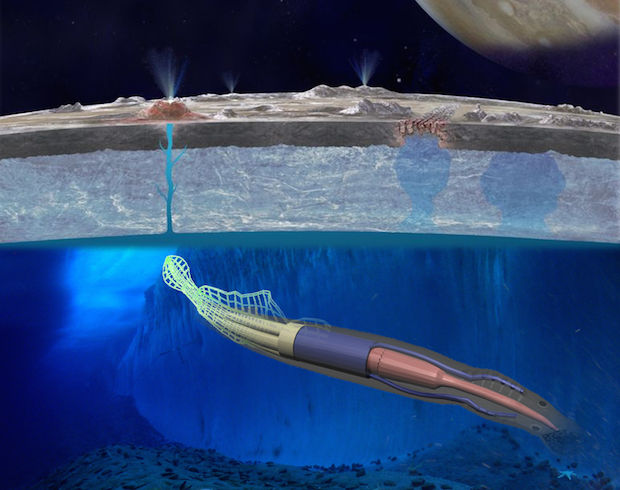Eel-like robot could explore extraterrestrial oceans
It is believed that under the surface of Jupiter's moon Europa there lies a vast subterranean ocean, and that this ocean could possibly sustain life within it. What could be more appropriate for plumbing those depths than an autonomous robot built to work -- and look -- like our own creatures of the deep?
A team of engineers from Cornell University has won a $100,000 grant from NASA to develop a squid- or lamprey-like autonomous robot that could explore the harsh and unknown conditions in Europa's subsurface ocean.
"This robotic concept is inspired by terrestrial biology, and may help us understand how creatures in an environment like Europa's ocean could gather energy to sustain life," said team leader Mason Peck, an associate professor of mechanical and aerospace engineering at Cornell.
The soft, flexible marine rover would only use resources in its extraterrestrial environment to power itself through the water. Without having to rely on its own battery or other fuel source sent from Earth, or hard-to-come-by solar energy, the robot would use its electrodynamic tentacles to harvest energy from changing magnetic fields around it. It would also electrolyze water, breaking in up into its constituents, oxygen and hydrogen, which it would store and ignite in its body and limbs. The gas would expand and deflate chambers that would create a natural swimming motion to propel the robot forward.
In his proposal to NASA, which garnered the $100,000 award as part of the agency's Innovative Advanced Concepts program, Peck explained that the robot could also be outfitted with a stretchy luminescent skin that could light up its immediate surroundings, like a wearable flash for optimal picture taking.
"This work will assess the possibility that any life on Europa may be powered by electromagnetic energy, with singular implications for astrobiology," Peck wrote. "That scientific benefit may influence future directions in Europa exploration. More broadly, this study will serve as a pathfinder that introduces soft robotics into future rover trades."
Last year, NASA earmarked $15 million to start planning a mission to Europa. No date has yet been set, but a program could be launched in the mid-2020s.

